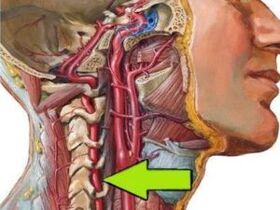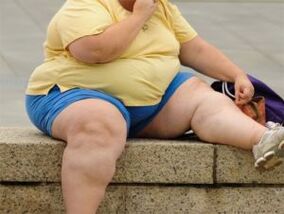Among all the pathological processes affecting the spine in its different parts, cervical osteochondrosis is considered one of the most common and painful.This disease leads to many complications, mainly because it affects the spinal cord, and also adversely affects the function of the brain.

What is cervical osteochondrosis?
The words of cervical osteochondrosis in medical practice mean a acquired progressive disease that affects the specific spine.This pathological process is characterized by degenerative-destrophic processes in the tissues of the intervertebral discs, which are shock absorbers for cervical vertebrae.Degenerative-district changes in the intervertebral discs are due to the fact that they have been deleted and deformed.As a result, the distance between the beads decreases and as a result the following consequences occur:
- Narrowing of the spinal canal in certain areas of the spine.
- Crossing vertebral arteries - large blood vessels that provide blood supply to the brain.Due to which the brain supply worsens and the blood flow to the cervical spinal cord is disturbed.
- The intervertebral discs can be deformed and flattened.This leads to the squeezing of individual sections of the spinal cord and nerves, most often, the nerve roots are squeezed.
All of these problems threaten not only a violation of brain blood circulation, painful neck sensations, headaches, etc.The development of osteochondrosis of the cervical region is dangerous with problems of a neurological nature, deterioration of the central nervous system, damage to the brain tissue.According to the international classification of diseases, some special codes were set osteochondrosis of the cervical region.The disease code for ICB 10 depends on the age of the disease: the disease was diagnosed:

- M02 - intervertebral disk dystrophy in adolescence.
- M42.12 is a dystrophic neck process in adults.
Many factors depend on the patient's age and the degree of development of the pathological process, for example, the consequences, complications, symptoms and, of course, the principles of treatment.
Causes
Recognizing the causes of the development of osteochondrosis of the cervical region can play a crucial role in the process of diagnosis, as well as determining the principles of combating the disease.However, before listing the reasons, it is worth saying that doctors distinguish two factors that lead to the development of this pathological process:
- Pathological - the destruction of intervertebral discs and other vertebrates with the inclusion of adjacent tissue, blood vessels and nerve beams in the pathological process under the influence of external adverse factors.The more difficult these factors and pathologies, the faster the disease develops.
- Physiological - based on the development of pathology, mainly age -related changes.We are talking about the natural aging of cartilage tissue in the spinal column, salts, etc.
If we list the most specific causes of cervical osteochondrosis, they are as follows:
- Violation of metabolic processes in the body as well as certain stages of overweight.
- Hippodynamia is a phenomenon characterized by a restriction of mobility.It is not just about injuries or illnesses, this can also include a sedentary lifestyle and sedentary work.
- Pathologies of the cardiovascular system, contributing to damage to blood circulation, pressure changes and other things.
- Incorrect attitude, these are different forms of scoliosis, rheumatism and even flat feet.
- Cervical back injection.In this case, we are talking about sprains, strikes, bruises.Other spine investigations in the development of cervical osteochondrosis can affect the development of cervical osteochondrosis.
- Excessive physical exercise in the cervical region caused by intense or severe physical sports, depending on the type of human activity.
- A sedentary lifestyle is also dangerous with a constant tension of the cervical back and the entire back, if you sit incorrectly or in unpleasant furniture.
- A cervical spine hernia as well as various related diseases.
- Forced long -term head holding in an unpleasant or unnatural position.In this case, not only the muscle overload occurs, but the spine is also curved in the cervical region.
- Doctors consider constant stress and nerve overload a very common cause.
- One of the reasons is also considered congenital abnormalities in the spine structure.

What is the risk to health?
As mentioned earlier, in the cervical spine, not only the spine and various nerve branches are located, but also the spinal arteries that supply the occipital part of the brain, cerebellum and medullav brain.With the development of cervical osteochondrosis, nearby tissues are inflamed.Moreover, the development of pathology threatens to squeeze the nerve roots and transmit blood vessels, the consequences are as follows:
- Osteochondrosis is associated with spinal deformities, a consequence of which the cerebrospinal canal is narrowed to certain areas.This can lead to squeezing the spinal cord and nerve branches, which promises severe neurological problems.In severe cases, a person feels pain, and there is even the possibility of losing control over individual parts of the body (mainly in hand or face).
- The squeezing of the neck vessels, as already mentioned, is associated with a violation of blood circulation in the occipital region of the brain.At the same time, the brain ceases to obtain oxygen and nutrients in the required quantities, oxygen hunger begins.With circulatory disorders, there is a real risk of ischemic stroke and various neurological pathologies.
syndromes
The main syndromes are:
- Vertebral.
- Vertebral artery.
- Koreshka.
- Cardiac.
It is important to know that each of these symptoms is associated with painful sensations of a different nature, as well as many unfavorable clinical signs.A person can feel dizziness, a noise appears in his ears and much more.

Vertebral syndrome
It talks about the direct bonding of osteochondrosis of the cervical region with bone tissue and cartilage.Symptoms in this type of pathology are also associated with the lesion of the tissue mentioned:
- Neck movements are partially or completely limited.
- Head movements are associated with neck pain.
- X -Ray indicates morphological changes in the tissues (intervertebral and in the body of the vertebrae).
It is worth noting that vertebral syndrome is always accompanied by these three clinical signs.If at least 1 of them is missing, the diagnosis will be completely different.
Novice syndrome
Occurs when the roots of the spinal cord are damaged.At the same time, nerve conductivity worries, a person may feel pain or lose the sensitivity of individual parts of the body or even suffer from paralysis.Depending on which of the 8 radical couples there is a conduction concern, such symptoms are distinguished:
- 1 pair - numbness or pain in the back of the head;
- 3 pairs - violation of chewing reflex, numbness of the tongue and unpleasant sensations behind the ears;
- 4 pairs - pain in the clavicle, violation of swallowing reflex;
- 5 pairs - shoulder band violations, accompanied by the problem of hand movement;
- 6 pairs - the patient begins to feel pain and numbness in the forearm of the blades and shoulders;
- 7 pairs - hands and fingers go numb (often index and middle);
- 8 pairs - problems similar to the previous article, but the numbness is felt on the ring finger and the little finger.
Cardiac syndrome
Despite the fact that the pathological process is still localized in the cervical spine, the syndrome has all signs of heart pathologies.The clinical picture is as follows:
- Fast pulse.
- Pain in the sternum region.
- Shortness of breath, weakness, lethargy, decrease in performance.
Signs and symptoms of cervical osteochondrosis
To seek a doctor in time, it is necessary to clearly understand the signs of cervical osteochondrosis.In some cases, such knowledge allows you to seek help in the early stages of the disease when it is easier to treat.In general, the symptoms for cervical spine osteochondrosis are as follows:

- Pain for osteochondrosis is always present, only intensity and frequency change.Pain is pain that is the first clinical sign.Their intensity depends on the stage of progression of the disease, in nature they are stupid or squeezing.Painful sensations are mainly present in the neck of the occipital region, but can also radiate to the temporary region, shoulder band and hands.
- In most cases, there are manifestations of the vestibular apparatus lesion.We are talking about frequent dizziness without cause, nausea, impaired coordination of movements, uneven walking, loss in space.
- One of the most common clinical signs is the stiffness of the neck muscles and the stiffness of the movements.It is difficult for a person to turn, sit down, and throw his head away, the movements respond with periods of pain.
- Many patients notice the feeling that goosebumps "pass through the head of the head" or feels a characteristic tingling sensation.
- In the area of the hands there are weakness and numbness of the muscles.
- Often there are psychological manifestations, expressed in depression, drowsiness, a sharp change in mood, temperament or irritability.
- Due to damaged blood circulation and brain tissue damage, dizziness intensifies and noise in the ears appears, similar to rustling, pulsation, ringing.
- Most patients mark visual damage as well as pain in the eye of the eye, especially when trying to mow many eyes on the left, right, up or down.
It is sometimes possible to determine the degree of development of the pathological process according to symptoms.However, for a complete diagnosis of this, this is not yet enough and a number of diagnostic measures are required.
Diagnostic methods
Diagnosis of osteochondrosis of the cervical spine is necessary to determine the localization and stage of progression of the disease.For complete diagnosis, such diagnostic methods are needed:
- X -Ray - the main method that allows you to determine the degree and localization of spinal column deformation.
- You can use the calculated tomography for a more accurate diagnosis of pathological changes in beads and intervertebral discs.
- MRI (magnetoresonance images) - makes it possible to examine the wheels and beads in detail, determine the presence of hernia, extensions and degree of lesions of the rest.
- Doplerography - at the same time, examination becomes the opportunity to find a place for squeezing the artery, assessing the extent of circulatory disorders.
Treatment methods
Treatment of neck osteochondrosis always means an integrated approach.The principles of treatment depend on the mass of factors, such as the patient's age, the stage of development of the disease, the brightness of the clinical figure, etc.However, you cannot do without a doctor in this situation and first of all you can consult a therapist who will then direct you to a vertebologist.As for the integrated approach: osteochondrosis of cervical osteochondrosis is treated using drug therapy, physiotherapy, massages, exercise therapy and other methods to be discussed in more detail.
Treatment
The basis of cervical osteochondrosis treatment is medication therapy, which includes the use of tablets, medicines and medicines of such groups:
- Anesthetics - analgesics and antispasmodics.Former direct dull nerve centers, thus stopping painful sensations.The latter allows you to relieve neck muscle spasm, setting blood flow and pressing the pain.
- NSAIDs -Anti -Inflammatory non -steroidal anti -inflammatory are needed to reduce the inflammatory process, most of them also eliminate pain.Often these medicines are used in the form of gel, ointments that rub in the affected area.
- Musorelaxants are another way to remove muscle spasm in the cervical region.
- The chondroprotectors are mandatory at certain stages of osteochondrosis of the pieces because they contribute to the restoration of bone tissue.
- B vitamins - normalize the metabolic processes of nerve tissue, improving the conductivity of nerve impulses and contributing to the work of the central nervous system.
Remember, treatment should only be performed under the supervision of a physician who is responsible for the appointment of each drug, as well as determining the duration of its taking and dose.
Physiotherapy
The treatment of neck osteochondrosis will be many times more effective using some physiotherapy techniques:

- Electrophoresis.
- Laser therapy.
- Ultrasound.
- Massage
Massage therapy is necessarily performed by a worker with health experience, treatment is performed by a course of at least 10 sessions.Cervical region massages help normalize blood circulation, restore elasticity, muscle tone, relieve pain, etc.
Manual therapy
Manual therapy is based on the principle of resetting motor functions and mobility between the vertebrae.Initially, manipulations are in a slight relaxing massage, then the doctor joins more and more strength, acts on the pressure beads and neck curves.
The use of Kuznetsov applicants is one of the methods of therapy for spinal diseases, including osteochondrosis.The effect of adaptation in the cervical region normalizes metabolic processes, relieves pain, increases muscle tone, improves blood circulation, increases nerve tissue conductivity, etc.To prevent osteochondrosis, it is useful to include in swimming and hang on the horizontal bar for 2-3 minutes daily.


























































































